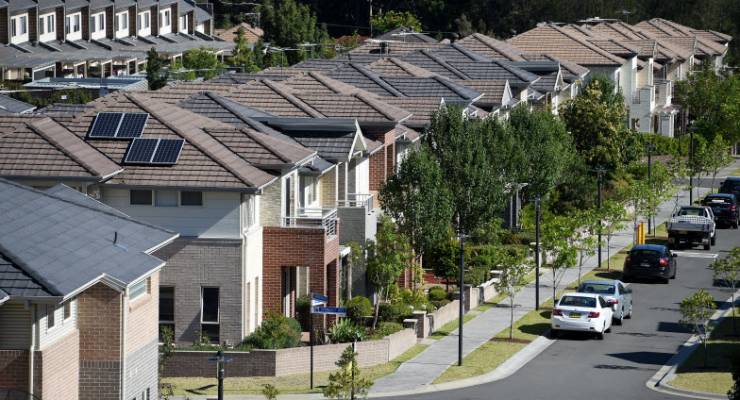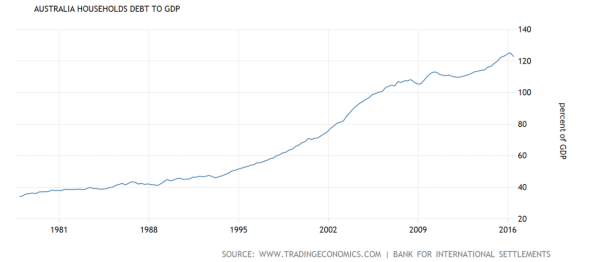
We’ve long gone past the “are we in a housing bubble?” debate phase, with even the most strident housing bull no longer denying Australia’s housing affordability problems. The question has now shifted to how can we make housing more affordable.
Before we can solve the housing affordability problem, we first need to acknowledge the primary causes of the bubble.
The first is Australia’s banking system and the banks’ extraordinarily tolerance for risky mortgage debt (aided, in no small part, by the Reserve Bank’s idiotic slashing of interest rates in recent years). Take the Commonwealth Bank, which makes up around a quarter of Australia’s mortgage market (it has $456 billion of mortgages on its books, which are an asset on its balance sheet). That is up more than $33 billion in the last year. So there is an inherent conflict here: by lending more and more money to home-buyers, banks are loading more risk onto their balance sheet. However, in the short-to-medium term, the more banks lend, the more they make in profit (which leads to higher executive salaries).
So you’ve got the RBA lowering rates, which means borrowers need to repay less each month, and at the same time, banks are lending more because it boosts short-term profitability and, notionally, borrowers are able to borrow more as repayments are lower. House-buyers will generally spend as much on a house as their bank will lend them; the more banks lend, the more house prices go up. It’s no surprise that while prices have skyrocketed, the percentage of Australian household debt to GDP has risen from 50% in 1997, when the boom commenced, to 123% now.

In conjunction with a foolhardy RBA and profit-hungry banks, the bubble has been underpinned by a series of government policies that have benefited a small segment of voters: wealthy baby boomers who own property. The Liberal Party looks after this slice of voters because they are a core support base. Labor has backed the policy out of an apparent fear of looking like a party hostile to business (and the Liberals are running a pretty smart, albeit highly dishonest, scare campaign). The specific policies that have exacerbated the bubble are: the principal residence capital gains exemption; negative gearing; discounted capital gains tax (CGT) on investment properties; and a lack of a broad-based land tax.
[Leaked minutes from govt cabinet meeting on how to deal with housing affordability]
One small side point before I explain how to fix the bubble: higher house prices are bad for almost everyone (not just renters who are trying to buy their first home). The only people who should be encouraging higher house prices are those who own multiple investment properties. If you own only your principal residence, there is no reason to want higher house prices — at some point, you will probably buy another property, and the higher its price, the more you pay in stamp duty and agent’s fees (as well as council rates). Then there’s the fact that money invested in land is money not invested in productive assets. (There’s also the fact that many baby boomers sitting on multimillion-dollar properties have children who can’t afford to buy a first home — this has led to loans from parents to their kids increasing almost 50% in the last decade.)
OK, so now perhaps everyone (other than perhaps wealthy land barons) agrees expensive housing is a problem that needs fixing, but what’s the best way to do it?
The first and most obvious is the RBA pricing money at its natural rate, not an artificially low rate to stimulate consumption and investment. As any first-year economics student is told, the natural interest rate occurs when nominal interest rates, less inflation, equal the growth rate. In Australia’s case, the RBA has set interest rates at 1.5%, but our (dubiously calculated) inflation rate is around 1.6%. The problem is our growth rate (even after a terrible last quarter) is still 1.8%. To be at the natural rate, interest rates should be at least 3.4%. That would have a significant effect on housing affordability literally overnight.
But fault doesn’t merely belong to our blundering RBA and bonus-seeking bankers. Our taxation system would make the Sheriff of Nottingham blush, being clearly designed to punish the poor and reward the rich.
While negative gearing attracts the majority of column inches (and is certainly a factor in investors overpaying for houses), a bigger problem is the less-talked-about principal residence CGT exemption. That is, there is no capital gains tax payable on the sale of a primary residence, no matter how much profit has been made by the seller. Two cases in point: last year philanthropist, Tony Smorgan sold his Toorak mansion for more than $24 million — the property was bought in 2005 for $4.5 million. The approximate $15 million profit (some renovations were done to the house) would have (almost certainly) been completely tax free. In Sydney, IT entrepreneur David Shein and his wife sold two Vaucluse properties for around $60 million to Menulog founder Leon Kamenev. Domain estimated Shein’s capital gain was as high as $50 million. Again, not a cent of that profit is paid in tax.
Multiply this hundreds of thousands of times across Australia, and there’s a lot of forgone tax staying in the pockets of Australia’s wealthiest people. Removing the principal residence exemption can easily be staged: instead of paying no tax, an indexed levy of 5% of the capital gain for sale prices of $1 million or less, 15% of the gain between $1 million and $2 million, 25% to $5 million, and 50% above $5 million, would raise significant funds without unduly penalising home-sellers.
Adding to the unfairness of our tax system is the oft-forgotten fact that infrastructure spending, which is paid for by all taxpayers, is generally capitalised in housing values. Using an example, let’s say the Victorian government decides to spend $10 billion on a brand-new train line to Doncaster. That new infrastructure makes houses in Doncaster more desirable, which leads to higher rental prices and higher property prices in and around the area where the train stations are built. Landowners benefit from the price appreciation (and don’t pay any tax on the value gain), while renters, whose income taxes partly paid for the train line, are forced to pay higher rents or a higher price for their first home.
[The property market is completely bonkers and so are you to buy into it]
Then there’s property (or land) taxes, virtually non-existent in Australia, outside investment properties. A broad-based property tax would allow a significant reduction in income taxes (and further reduction of capital gains taxes on productive assets like businesses, which actually employ people). The Grattan Institute suggested a mere 0.2% land tax on unimproved value would raise $7 billion annually.
Those two very simple measures would not only fix housing affordability virtually right away, but they also cure serious economic imbalances. Low interest rates mean savers (especially pensioners) are penalised in favour of borrowers. While negative gearing costs taxpayers $5.5 billion (according to the Grattan Institute), the principal residence exemption costs $46 billion a year. That would turn our $37 billion budget deficit into a surplus literally overnight, while a broad based property tax would allow income taxes to be lowered, or be given to the states to replace lower stamp duty revenue.
Imagine that: fixing housing affordability and balancing the budget in one fell swoop. The only problem is that would require politicians to actually care more about the voters than being re-elected.
*Adam Schwab is a corporate former lawyer, author, CEO of the Lux Group and was the 2015 Young CEO of the Year








you should always be careful when underpinning your bubble- things can get messy
“banks’ extraordinarily tolerance for risky mortgage debt (aided, in no small part” by the large bonuses paid by bank management to themselves.
Keeping the bonuses expanding resulted in a wide range of unethical and corrupt practices.
Time perhaps for a Commonwealth-owned bank run by public servants with decent pay and no bonuses. They might even direct investment into manufacturing industry rather than bidding up the price of existing housing.
I agree that the RBA has fluffed it badly on interest rates and that for equity reasons the CGT discount should be abolished (on all asset classes, not just houses). Likewise losses claimed from negative gearing should only be claimed against income from the asset being purchased, not other salary and wages as at present.
But “…fixing housing affordability…in one fell swoop” by way of land taxes and removing the CGT exemption on the family home would have unintended consequences.
A .2% land tax would mean the stereotypical Sydney pensioner living in their own home paying about $700 per year (assuming $350K unimproved land value).
Tax cuts payed for by pensioners? Yeah, that’ll fly…
As for a CGT on the family home, would this mean interest paid on a mortgage will be tax deductible? Could the family home then be negatively geared? That could have quite the opposite effect on house prices.
Careful what you wish for…
Adam, you’re making too much sense here.
Duncan, I’ve read elsewhere an easy solution to the pensioner element – allow them to elect to pay the balance of the taxes from the sale proceeds of their estate. A certain amount of means testing may be needed for low income earners and those undergoing hardship to access this too.
SOCIALIST!
Genuine question because I’m a thicko: How does having higher interest rates without an increase in wages make housing more affordable for low-income earners? Wouldn’t both have to happen successively in order for it to be a more wholly viable system?
Craig – the theory is that higher interest rates would discourage some speculators/investors/blood sucking vampires from frivolously buying every house within claw reach. With less ‘demand’ the price would fall, Economics 101 and of course we all know how accurate economics is in dealing with the real world.
Negative gearing on investment properties is an obscenity.
In Britain during MrsT’s Bravura New Worlde they tried giving householders tax credits for the interest paid on their mortgages and that didn’t lead .. coff, coff.. to any inflation of prices.
Good question.
Thank you, AR! Only just now saw this!
I agree on most of this Adam, and there can be debate around the margins. Land tax on existing properties may have to be levied only at the top end, otherwise you will have pensioners unable to pay. CGT on family homes, again, why not just target the top end, for Sydney and Melbourne perhaps at the $3M – $5M mark would catch the greatest gains without hitting the average mug.
But fully on board re the interest rates. Low interest rates coupled with stupid tax policy mean that an investment home is almost essential as a way into the market these days. It is overwhelmingly a sop to wealthy baby boomers, and prices out our young. Banks are just climbing on board a gravy train, and so much money going to unproductive assets.